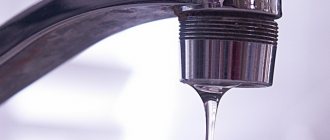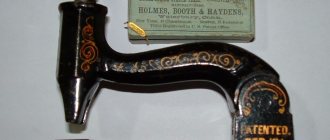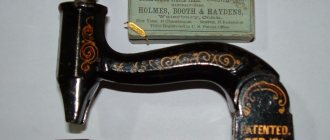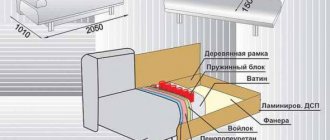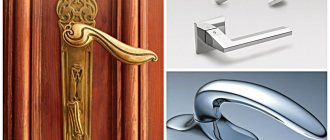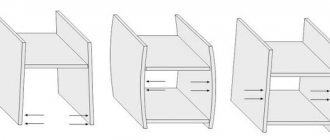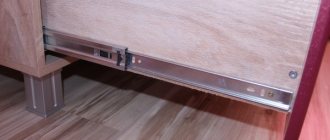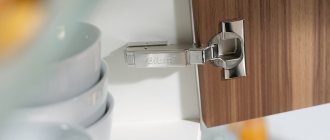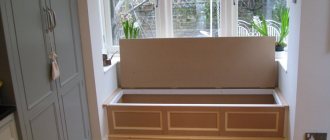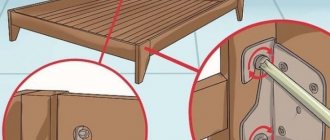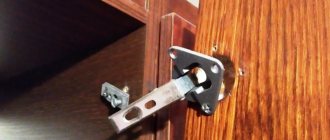A furniture stapler, or, as they also like to call it, a strobe shooter, is a very necessary thing. But sometimes, even when recently purchased, it begins to work incorrectly and either does not drive the staples into the tree completely, or they completely get stuck in the tool. In most cases, this can be “cured” by simple adjustments or is associated with improper use of the tool. But there are situations when the stapler has already exhausted its service life to such an extent that the parts in it have simply worn out or have worn out over time. How to fix a stapler so that it works again as before, and is it even possible to do this in principle?
Types of staplers and their purpose
A construction stapler is a device that is used to fasten various materials using special staples.
This device is also called a staple gun, staple gun, staple gun, or even a pistol. The tool is popular not only among furniture upholsterers, but also among workers in various fields. It is always useful in the household, because with its help you can quickly and efficiently connect two different parts. Construction staplers are divided into types based on the type of drive. What they are and how they differ, we will find out further:
- Mechanical is the most common type of device, which is popular not only among home craftsmen. The device is activated by applying physical force. The denser the material into which the staples are hammered, the more effort a person needs to put in. A mechanical stapler is characterized by its small size, low cost and lack of connection to an electrical network or compressor
- Electric - the principle of their operation is the use of electricity. The staples fire when the trigger is lightly pressed. The physical effort required to fire staples in mechanical staplers is replaced by an electric drive. It should be noted that electrical appliances are divided into mains and battery-powered. Mains ones require connection to an outlet, while rechargeable ones are more bulky and require regular battery charging.
- Pneumatic - if mechanical ones use physical force, and electric ones use the force created by an electric motor, then in pneumatic ones, the main drive device is compressed air. This air is supplied from a compressor, so the stapler is tied to the equipment, which makes it inconvenient to use. If electrical and mechanical models are used not only by specialists, but also by home craftsmen, then pneumatic devices are often used only by professionals. The advantage of the tool is its relatively low cost, which is higher than mechanical ones, but less than electric ones.
For home use, a mechanical stapler is sufficient, which, unlike an electric one, can be used in any conditions. Such devices are unpretentious, affordable and provide high reliability of work. It is about manual staplers that will be discussed in the material.
Working with a mechanical stapler
To learn how to carry out repair work using a construction stapler, you need to know about the basic rules of this process.
Charging the device
Before you start, for example, upholstering a sofa, it’s worth learning how to charge a stapler. This is done step by step according to the following algorithm:
- Installing the device on the fuse.
- A folding flap at the rear of the stapler reveals a compartment for staples.
- Pulling the rod with the spring out of the compartment.
- Installing staples with the upper bent part towards the handle of the stapler.
- Releasing the rod to clamp them.
- Slam the sash until it clicks and start working.
Some models have a different mechanism and therefore many people think about how to refill them. There is nothing complicated here either, just remove the special chute that appears when you press the button. The staples are installed into it with their sharp ends down. Afterwards the filled element is inserted back.
The process of charging a mechanical stapler with staples
We attach the staples to the base
After clarifying the charging instructions, it will not be amiss to find out how to use the stapler during direct work.
This is done like this:
- Prepare materials for fixation and the instrument itself.
- Mark the line along which the staples will be attached. This makes it easier to install fasteners exactly in the place where you plan.
- The stapler is applied to the desired place quite firmly.
- Without lifting the device from the surface, press the lever.
- After this, if everything is done correctly, a characteristic sound will be heard, and the bracket will be securely attached to the base.
Staple fixation process
Stapler device
Staple guns, based on the type of energy with which fasteners are driven into the surface of the material, are divided into the following types:
- mechanical;
- pneumatic;
- electric.
In everyday life, mechanical and electrical models of tackers are mainly used. Pneumatic tools belong to the professional category.
Mechanical models
Any furniture stapler has in its design a magazine for fasteners, inside of which there is a clip with guides. Consumables are inserted into it when performing work operations.
The magazines of some models have a transparent insert. This is convenient during work because it allows you to control the remaining amount of fasteners.
The device of a mechanical type staple gun is shown in detail in the photograph below.
The impact-return mechanism (striker) is a plate. Its size corresponds to the geometric parameters of the consumables used. The firing pin is attached to the striker - its shape is determined by the design of the taker. In this case, the other side of the hammer comes into contact with the spring, the compression of which is adjusted using a screw. Shock absorption is provided by a polyurethane shock absorber, which is located inside the body.
Manual staplers can be equipped with two types of springs:
- twisted (shown in the photo above), installed on inexpensive models;
- plate (spring type, photo below), more powerful and expensive compared to the first.
A mechanical staple gun is controlled by a lever (handle). He cocks the impact-recoil mechanism. During transportation or storage, a safety clip protects against accidental operation.
Technical characteristics of mechanical staplers
Knowing the structure and operating principle of mechanical type construction staplers, it is also necessary to understand their basic design characteristics. These characteristics include:
- Material - what the stapler body is made of. The most commonly used material is steel, while cheaper options are made from aluminum alloy. The simplest are products made of impact-resistant plastic, but they are not intended for frequent and prolonged use. The handle of steel and aluminum staplers can be covered with a rubber or polyurethane layer
- Dimensions and weight - all mechanical staplers are compact, so there are no difficulties with their storage and transportation. The length of the devices ranges from 155 mm to 230 mm, and the height varies from 120 to 200 mm. The width of 25-35 mm not only characterizes the dimensions of the tool, but also the possibility of using staples of different sizes. Hand-held models weigh from 300 to 800 grams, and if the device body is plastic, then their weight is even less
- Impact force - this parameter for manual staplers is the lowest compared to electric ones, and even more so, pneumatic ones. The impact force is regulated by a special screw, which is equipped with all models of staplers
- Impact frequency or rate of fire - this parameter is measured in the number of staples driven in one minute. For hand tools this figure is the lowest. Electric models show the following results - from 20 to 50 staples per minute, and the most highly productive are pneumatic counterparts, which fire 50-60 times per minute
- The depth of driving the staples - this parameter depends on the impact force of the tool, as well as the type of material for driving the staples. Mechanical staplers are capable of driving 10-15 mm staples, while their modern rivals, electric and pneumatic devices, can handle 50 and even 100 mm fasteners. However, on the farm there is rarely a need to connect various parts using such long staples, especially since it is much more reliable to make the connection using self-tapping screws
LiveInternetLiveInternet
A furniture stapler is widely used in the household; with its help you can easily nail down greenhouse film, cover furniture with fabric, and it will also come in handy in other situations. The variety of models will confuse the ignorant person, so in this article you will find useful tips on choosing how to use it, which brackets are suitable for which models. There are a wide variety of home staplers on sale; the first thing you need to pay attention to is the type of staple. The most popular and frequently used type of staple is type 53. Most models use type 53. This type has the following dimensions: staple width 11.4 mm, thickness - 0.7 mm. Of course, you don’t need to know these dimensions, you just need to know what staples your “pigalle” works on and their type. Secondly, what depth of staples can be driven in. Furniture guns can be simple (staples 4-8 mm deep, inexpensive). Most often made of plastic, intended for infrequent use. Only small staples are used, so they can only be used to nail fabric or paper. Cheap and simple, the price is about 100 rubles. Like these ones.
There are also options 4-10 (staples from 4 to 10 mm inclusive). Such pistols are already made of metal, although there is no adjustment screw. Yes, it is of no use, the staples can be driven in 10 mm without maximum adjustment. As a rule, type 53 staples are used. Staplers 4-14 mm (the very first photo in the article). The most popular and best-selling. Made of metal, solid, high quality. Use staples 4-14 mm deep with 53 type. The main difference from others is the presence of an adjusting screw, with which you can increase or decrease the impact force. As a rule, if the staple is more than 10 mm deep, then the screw must be tightened in the direction of increasing the impact force, otherwise the staple will not completely enter the wood. A wide range of bracket sizes (4,6,8,10,12,14 mm) will allow you to choose the optimal depth for the job. Among the good models, we can highlight reliable and high-quality ones, the price is 330 rubles. Also among the household models, it is necessary to highlight the model with bracket type 140. It is thicker, has dimensions: width 10.6 mm and thickness 1.2 mm. If you load type 53 staples into a type 140 stapler, it will shoot 2 staples at a time. Therefore, it is so necessary to know the type on which “pigalle” works. Most often, guns with 140 type support several types of staples, these are small nails and semicircular staples for driving in cables. We can say that this is a universal option, which is a pleasure to work with. However, it does not support the most popular type 53 bracket. The Stayer stapler, shown in the photo below, supports 4 types of staples: type 140, type 300, type 500 and type 36. Its price is 650 rubles.
Staple type 53 is the most used and is used in most staplers. Rectangular Bracket width 11.4 mm Thickness 0.7 mm. Dimensions (depth) 4-14 mm. Sold in packs of 1000 pieces. There are 2 types: hardened and simple. Tempered ones are used for strong or laminated wood (chipboard). Regular staples are 2 times cheaper and are designed for soft wood. Type 140 Powerful, thick staples, also used for fastening materials to wood, plywood, chipboard. Rectangular bracket. Width - 10.6 mm Thickness - 1.2 mm Dimensions 4-14 mm Packages of 1000 pieces. The cost is higher than that of type 53 staples. Type 36 Semicircular cable clamps. Bracket width - 7.6 mm (cable with a diameter of no more than 6.4 mm can be pinned) Thickness - 1.2 mm Dimensions - 10, 12. 14 mm Type 300 Small nails with a T-shaped head. Used for fastening to wood, wood, chipboard. Nail thickness - 1.2 mm Dimensions - 10, 12 and 14 mm. Type 500 Carnations without a head (finish type). In general it looks like type 300, only there is no cap. Dimensions - 10,12, 14 mm. If you are engaged in furniture production and use the corresponding tool constantly in hard mode, then ordinary household models will not last long. Therefore, there are professional options for such purposes. The RAPID tool has proven itself to be excellent. This company specializes in the production of only furniture guns, so they are of excellent quality. However, their cost is rather high, for example. A standard gun for type 53 staples costs 2,200 rubles. However, according to reviews from customers who bought a couple of these models from us, they are very strong. Before that, they bought ordinary household ones, but they often broke down. Therefore, it was decided to buy 1 professional one for testing - it outlasted 10 conventional staplers. As you can see, the difference is simply huge. For home use, an ordinary inexpensive one, for example, will be enough. How to insert staples For those who are picking up a stapler for the first time, this can be a problem. But after the first time you will learn right away, nothing complicated. Here's a photo for you.
First, take out the “staple pusher” with the spring from the gun, then insert the staples with the point down and push them in with the “spring thing” until it clicks into place. Preparing the stapler for use Pull out the latch, which is located at the back of the stapler. Insert the staples into the special groove. The staples should be inserted with the tips facing down. (P) Reinstall the latch and spring. The stapler is ready for use. How to use a stapler Place the stapler firmly against the surface where you want to drive the staple. Without lifting the stapler from the surface, press the lever until you hear a characteristic sound. This action will require mechanical effort. If the staple does not fly out, it means it is stuck and you need to get it out by completing 4 steps to prepare the stapler for use. Ready. The staple has been successfully driven in. In order to avoid injury from a furniture stapler, it is important to thoroughly understand how to use such a tool. If you are using a mechanical stapler, first adjust the adjuster screw. The adjustment must be made on the rough material, rotating the regulator from minimum to maximum. If the fastener does not enter the material from the first blow, then you will need to adjust your furniture stapler again, and if it does, then start working on the “finishing” part. To drive staples at the required distance, it is best to mark such places in advance using a pen or pencil. You can also use a clamp, which must maintain the same distance when driving in fasteners without preliminary markings. Don’t forget to also hold the material while making shots so that the material cannot move when driving in the staple. Do not forget to also monitor the presence of staples so as not to be left without them at the most inopportune moment for you. When the tool is not in use, secure the handle with the safety lock. This is required for safety reasons. By following these simple recommendations, you can easily cope with upholstery of a sofa or other necessary task associated with a furniture stapler; the price always depends on the type of tool and its manufacturer. Construction stapler repair.
Additional options
It seems to many that a stationery stapler is a fairly simple device that cannot be improved in any way. But manufacturers are making it more convenient to use. So, when purchasing, pay attention to the fact that there is a plastic footrest or rubberized inserts at the bottom. They will protect your table from scratches.
Another important and convenient addition is the presence of a built-in destapler. This is a special device with which you can quickly straighten the staples. It will come in handy in situations where you need to separate previously fastened sheets. It is inconvenient to pick out staples with scissors, much less with fingernails, and it looks unsightly.
Stapling Types
There is also an open type. In this case, the staples are bent outward. This method is preferable to use in cases where only temporary stitching of sheets is necessary. Papers fastened in this way can be easily separated, and the marks are practically invisible.
Sometimes in offices they use a special stationery stapler with straight staples. It is necessary in situations where it is necessary to attach paper (some kind of announcement or document) to a special board with a soft surface. It can be made, for example, from cork.
How does a furniture stapler work?
The operating principle of a furniture stapler is based on:
- Pushing out a fastener by the force of a compressed spring under the influence of physical force or electric current.
- In pneumatic models, instead of a spring there is a piston driven by compressed air.
- After the trigger is pressed, the energy of the spring or piston is transferred to the firing pin.
- The impact mechanism hits the bracket, thereby driving it into the surface.
- A furniture stapler is used to fasten surfaces of different hardness, so before use, the impact force must be adjusted to the material using a special adjustment mechanism, which differs for different types of tackers.
Electric and pneumatic models
The device of an electric tacker connected to a 220 V network is shown in the photo below.
The numbers indicate the following structural elements:
- trigger;
- fuse;
- handle for holding the tool;
- power cable;
- on/off button;
- mechanism for regulating the force of the shot;
- magazine pusher;
- magazine lock.
Inside the instrument body there are also:
- an electric motor that charges the spring;
- electric motor control board;
- impact mechanism.
Battery products do not have a power cord. The power tool receives power from batteries.
Individual design elements of pneumatic staple guns are shown in the photograph below.
Inside the pneumatic tool there is a cylinder with a piston, as well as an air distribution unit. Compressed air for the operation of a construction stapler is supplied through a hose that can withstand high pressure, from a compressor unit or cylinder. Therefore, if problems arise with the operation of a pneumatic tacker, you first need to check the serviceability of the compressor with the air duct.
Classification
There are different types of construction staplers: staplers.
Manual
This category also includes manually operated mechanical devices.
These devices hammer the staples in with forceful blows. Compared to manual analogues, the performance of this model is much higher. This tool is convenient for performing the following work:
- Fastening insulating material.
- Installation of roofing felt.
This tool is used for installing cables with a voltage load of 50 V. The maximum cable diameter is 7.5 mm. These staplers are used when performing the following work:
- Cable fixation.
- Laying an electrical network.
- Installation of communication lines.
Classic model
This hand-operated tool has become a true classic. After the release lever is pressed, the staple is driven into the material. A special category is hybrid models, with which you can perform several types of described operations.
They have only one drawback: a relatively high price.
Operating principle
Depending on the type of drive, tools are divided into electric and pneumatic.
Electrical
These devices are widely used in everyday life. Working with an electric stapler is a pleasure; you just need to connect the device to the power supply. However, an electrical device, in comparison with its manual counterpart, is much more expensive. It is profitable to buy it for professional craftsmen who are constantly repairing furniture. Naturally, it is not profitable to buy such a model for a one-time repair. Manual models are suitable for household use.
Pneumatic
These models are not used in everyday life, since their use requires a compressor unit. You can buy your own compact compressor, but how quickly such a purchase will pay off is the question. Therefore, buying a pneumatic device is beneficial for companies producing and professionally repairing furniture.
What kind of staples are produced for construction staplers?
Staples are consumables that are needed to connect two elements (fabric to wood). Consumables are divided into various types according to the following criteria:
- Material of manufacture
- Degree of hardness and strength
- Availability of additional protective coating
- Dimensions
- Form
Let's consider what types of staples there are, depending on the above criteria.
Material for making staples for a stapler
Manufacturers produce staples from various materials, which allows them to expand their scope of application. They come in the following types:
- Aluminum - used for working with non-solid types of materials
- Copper - these staples are also called decorative, as they are intended for covering furniture with various types of fabrics
- Steel ones are the most popular and inexpensive. They can be used for driving not only into soft, but also hard materials. The main disadvantage is that they rust over time.
- Stainless - made of stainless steel, and used when it is necessary to prevent the occurrence of corrosion processes
Additional zinc coating of the brackets eliminates the occurrence of corrosion processes. When choosing fasteners of the appropriate material, it is necessary to take into account what you plan to connect.
The hardness of staples and what it affects
The greater the hardness of the consumable, the higher the efficiency of its penetration into the surface of the driven material. To understand why staples of different hardnesses are produced, you need to imagine a picture when it is necessary to drive a staple into a board made of hard wood. A soft aluminum or copper staple will not penetrate the surface of such wood. The result is a damaged bracket with bent legs. To prevent this from happening, manufacturers produce consumables with the following hardness names:
- Simple
- Very hard
- Red-hot
How to hammer staples into plywood with a hand stapler? Is there a shock adjustment?
There is a manual stapler Stayer 3150. It does a good job of driving staples into wooden boards. And then it was necessary to pin a fabric support to a piece of plywood, to a thin, ordinary three-piece plywood. And the brackets will only fit in there a couple of millimeters, but nothing further. When you try to finish them off with a hammer, they bend, complete nonsense. Is the trick in parentheses or something else? But I think my braces are also Stayer, branded. recommended according to passport A-053 type. Maybe there is something tougher? Which ones to look for? Or are there some cunning special methods of work, such as making sure to make the sign of the cross over yourself?
Is it possible to adjust the impact force? There is some kind of screw with a notch sticking out from above, but by God, I did not understand the relationship between tightening or unscrewing it with the depth of driving the staples into the plywood.
I understand that there are supers with a compressor - those are no problem, but for the sake of a dozen staples it’s worth looking for some smarter way to achieve your goal. Surely someone figured out some trick. Share, please!
T-34, use this screw to adjust, and try placing something solid under the plywood. If that doesn’t work, try searching for “steel, hardened with bevel (for hardwood, chipboard and plywood)”
Kubera wrote: If that doesn’t work, try searching for “steel, hardened with bevel (for hardwood, chipboard and plywood)”
And it’s better not “branded”
T-34 wrote: But it seems like I also have Stayer braces, branded ones.
And branded ones. Rapid or Novus. Type 53.
Alex___dr, I have staples from “Fit”, though type 140, and a splinter “Zyubr”
These seem to be thicker than type 53.
Alex___dr wrote: These seem to be thicker than type 53.
type 53: width 11.4, thickness 0.7 mm; and type 140: 10.6 and 1.2 mm, respectively, but type 53, judging by the Internet, also has hardened staples
Kubera wrote: type 53: width 11.4, thickness 0.7 mm; and type 140: 10.6 and 1.2 mm, respectively, but type 53, judging by the Internet, also has hardened staples
Yes, but what about the issue of interchangeability? Will 140 fit instead of 53? You can’t push them into the staple receptacle, it’s tight there. And these are 10.6 and 11.4. And there seem to be no complaints about the staples - they do not bend or deform upon impact. They just stick in a little, but don’t pierce through the plywood and don’t shoot the sackcloth to the plywood. This neat letter P sticks out.
How to use a construction stapler correctly
Before using the tool, you must first select the appropriate type of brackets and install them in the device compartment. To charge a new fastener, the following manipulations are carried out:
- The first step is to block the device handle from accidentally pressing it.
- At the back of the tool there is a special hatch with a rod and a pusher (removal mechanism), when removed, a compartment opens for installing a cartridge cassette of staples
- The cassette is installed inside the compartment, turning it so that the legs point down
- Next, we return the ramming mechanism to its place, thereby pressing the staples
- The handle is removed from the safety lock
- The tool is ready for use. Now you can make a few test shots to make sure the device is working.
In a similar sequence, staples of different sizes and shapes are installed or charged. However, before installing the appropriate fasteners into the tool, you must make sure that it is designed to work with them.
After this, you can begin to use the construction stapler for its intended purpose. It is not difficult to work with a furniture stapler, and the only regulator is to adjust the impact force. If, when you try to drive in the staple, it does not go in all the way, then you need to rotate the adjuster in a clockwise direction. If the fastener is deeply recessed inside the material, then it is necessary to loosen the spring pressure.
This is interesting!
When the staples in the gun run out, it is not recommended to click the handle idle. The mechanism of the tool wears out with each blow, so the device will not last long in this case.
Features of adjusting the impact force for household and professional staplers:
- Features of setting household staplers - tightening the screw clockwise helps compress the spring. As a result, the staples are fired with greater force, which will also contribute to its penetration deeper into the material. If you turn the regulator in the opposite direction, the blow will be weaker
- Setting up a professional stapler - the regulator is located near the handle. When it rotates, the impact force also increases or decreases. The tool needs adjustment every time the material being processed is changed.
The tool is considered to be correctly adjusted when the staple is completely inserted into the material. You should start using the tool only after the impact force has been correctly adjusted.
This is interesting!
Often, during the operation of a furniture stapler, a situation arises when the staple does not completely enter the material. The reason for this phenomenon is that the spring wears out. If you adjust the impact force of the screw to the maximum value, and the fasteners do not go in completely, then the tool needs repair.
Review: Furniture stapler Ermak – From an old sofa to a new one
We asked the specialists and they gave us a bill of 12 thousand rubles. We decided that given its cost of 15 thousand five years ago, it was better to buy a new one. While we were assembling the new one, a very simple thought came to mind - to try to do everything with our own hands. I took care of the pillows, and my husband bought himself an Ermak furniture stapler from a Chinese manufacturer.
It took 3,000 rubles for everything. The stapler cost 450 rubles! And a hundred rubles of staples.
The stapler is very simple.
We, as indicated in the instructions, insert the staples into the stapler
In order to adjust the spring in the stapler there is a special device; it is this device that regulates the impact force.
But the seller warned that you shouldn’t tighten the springs too much, as they say it will last longer. The handle of the stapler has a safety loop so that when you are not using it, you can protect yourself from injury when it is triggered.
The staple flies out of a special hole, which must be pressed tightly to the place where the staples must be driven in and the fabric secured to the wooden surface.
First, we carry out “idle” shots to understand how well the spring is tensioned. My husband specially selected a tree similar to the one our sofa is made from. There is a sharp click and the staple is already in the wooden surface
She came in like family. Now we can start updating our furniture.
The fabric was purchased in advance from a furniture store. We chose a “sack” with it somehow more comfortable. The sofa is subject to disassembly. And its two seats, which we will reupholster, are installed on a hard and stable surface. To properly fasten the fabric, we follow the same “footsteps” that the manufacturer used to fasten the eco-leather.
The stapler fastens the fabric confidently and without much physical effort. Several staples were wasted, since the structure of the wood is still heterogeneous.
But for the most part there were no complaints and this indicates a fairly good quality of the stapler. The result is that in two hours of work in the family workshop, we received an updated and quite nice sofa for the kitchen.
And accordingly, we saved more than ten thousand rubles, which could have been successfully spent on other needs. Don't be afraid to pick it up and try to make your home more comfortable.
Source: otzovik.com
Common malfunctions of construction staplers and their causes
A construction stapler of any kind may begin to malfunction. At the same time, the common malfunctions for the types of staple guns considered are the same. Only the reasons why the breakdown occurred may vary greatly - this is due to the design differences between different types of tackers. Let's look at what to do in each case.
The tool does not work - the staples do not fly out
So, if an electric or mechanical staple gun does not fire staples or nails, then the reasons may be the following:
- the spring is broken;
- problems with the drummer.
In mechanical devices, the mechanism for engaging the cocking lever with the spring may also wear out.
In a power tool there are other possible reasons why the fasteners do not fire:
- the instrument is not included in the 220 V network;
- the cord is defective (its integrity is compromised);
- the electric motor burned out;
- The board that controls the operation of the electric motor has failed.
Electric stapler board Novus J-165-EAD
The pneumatic tool does not fire consumables in the following cases:
- the compressor is broken or not connected to the mains;
- the hose is broken;
- the compressed air in the cylinder has run out;
- problems with the cylinder, piston or air distribution system.
The fastener gets stuck
Consumables in all models get stuck for common reasons:
- when it does not correspond in size to the tacker being used;
- the fasteners or the magazine are dirty from the inside;
- used consumables with defects, for example, bent.
There are staples in the store, but the stapler does not hammer them in
How to fix a stapler in such a situation? Most likely, in this case, you just need to lubricate the head of the staple clamping mechanism. You should open the magazine, remove the staples, drop oil on the rammer and develop it. When you are satisfied that the rammer slides perfectly in the magazine folding frame, reload the staples and test the tool.
Problem with bent staples
In this case, the material is too dense for the staples you choose. This can be treated either by purchasing stronger branded staples made from high-quality metal, or by replacing longer ones with shorter ones. Staples with short legs will fit into dense material without any deformation, and will hold almost the same way as long ones, due to the hardness of the wood or other material into which they are driven.
The staples are not driven in completely or, conversely, too deeply
Any staple gun will not drive staples, nails or pins completely if the depth control is not set correctly. In such cases, it is enough to adjust it correctly. For manual and electric devices, the problem is also often associated with spring wear, and for pneumatic devices, with the clamping mechanism or insufficient operating pressure.
If the fastener is driven in too deeply, the cause may be a compressed spring or high compressed air pressure.
Important! When using a pneumatic tool, the compressed air pressure can be increased no more than to the value specified in the operating instructions.
When fired, 2 staples fly out
One of the most common problems with a furniture stapler is that several staples come out at once. The striker is responsible for this moment. If it is even slightly bent, the staples will get stuck and come out every once in a while and, as a rule, in tandem. Moreover, each time the firing pin will deform more and more, aggravating the situation.
Problem with bent staples
The occurrence of such an unpleasant situation when working with a construction stapler is possible when using very dense material.
This makes it difficult for the staples to fit into or bend. If you need to work with dense material, it is recommended to first purchase high-quality brackets made of durable metal.
You can also cope with this problem by using a consumable with short legs. They fit into dense material much easier, providing an equally strong bond. In this case, the staples are not subject to deformation. The strength of the fastening is ensured by the density of the material or wood.
Do-it-yourself repair of a construction stapler
Often during the operation of tools, their malfunction occurs. A mechanical stapler is no exception, repair of which may be required soon after purchase if the cheapest option is purchased.
Let's look at the features of repairing a furniture stapler using the example of a malfunction when two staples shoot out.
Why does the stapler shoot two staples, and is it possible to fix such a breakdown? First we need to figure out why it shoots two fasteners. The reason for this malfunction is the weakening of the clamping force of the staple cassette. The pressure is provided by the rammer. Over time, the spring loses its clamping properties, which leads to a defect when the device fires two staples at once.
You can fix this in the following way:
- For staplers with a spring type of spring, make a U-shaped plate and place it between the latch and the rammer. Such a plate will eliminate free movement of the rammer, and as a result the stapler will hit exactly one staple
- For staplers with coil springs, increase the force of the rammer spring. This can be done by adding spacers in the form of washers
A detailed description of the mechanical stapler repair process is presented in the video material.
No less popular is the problem when staples do not fly out of the stapler.
If in the first case the problem is solved without the need to disassemble the device, then here you cannot do without it. It is easy to disassemble the stapler, depending on its model. To do this, remove the cotter pin washers, and then disassemble the tool. Next you need to get to the impact mechanism, since the malfunction is associated with it. Repairing a construction stapler with a malfunction such as staples not firing is as follows:
- The sides of the striker are inspected
- There should be no licked areas where they come into contact with the handle. The presence of such indicates that the striker does not move to the upper position, but jumps off almost immediately when you press the handle
- The licked areas of the edges must be ground off with a grinder, after which we can assume that the tool has been repaired
- All that remains is to assemble it and check the proper functioning
Another type of failure of a mechanical stapler is when the staple shoots out in the shape of the letter “M”.
This type of fastening is not reliable, so the problem must be corrected as quickly as possible. We will consider the reasons for this malfunction and the features of its elimination below:
- If the staples jam in the shape of the letter “M”, then the reason is the development of the striker
- The firing pin is a plate that is connected to the firing pin
- This type of breakdown often occurs due to the fact that the firing pin is made of low quality steel. With prolonged use of the tool, abrasion of the end part of the striker occurs, which contributes to the creasing of staples in the shape of the letter “M”
- Alignment of the striker is carried out using a fine-grain file
- It is important to take into account that it is not recommended to remove a large amount of edge from the striker, as this will affect the reduction in impact force
After repairing the construction stapler, you can continue to use it. The instrument in question is distinguished by its versatility, for which it has gained wide popularity. In conclusion, it should be noted that, like any other type of tool, a furniture stapler needs lubrication. The impact mechanism is lubricated with lithol or grease, which reduces friction and therefore increases the service life of the device.
Repair and replacement of the striker
With active use of a furniture stapler, the firing pin wears out over time. In addition, today's instrument market is filled with Chinese consumer goods. The models can only boast of their cheapness, while the quality of workmanship is at a terrible level: the metal is too thin, the dimensions of the elements are poorly adjusted, mediocre assembly, etc.
Repairing this part cannot be called too complicated, but some skill will still be required. It is also worth preparing a number of tools:
- screwdrivers – Phillips and flat head;
- rough file;
- pliers;
- heavy hammer;
- bench vice.
Almost all budget and mid-budget models have the same design and differ only in build quality and the materials used. Therefore, the repair procedure is approximately the same.
Disassembling the stapler:
- Open the receiver and free it from the remaining staples.
- Loosen the adjusting bolt completely.
- We remove the spring through the top (sometimes side) hole.
- We carefully disassemble the structure, putting the parts on a rag.
The main elements are held on the body by pins. One part of the latter consists of locking washers, and the other of cast caps. In a good half of cases, the impact mechanism is blocked by a pair of such pins.
Next, we clamp the firing pin in a bench vice, and then level it with a hammer, pliers and a file, trying to give the surface its original shape. After completing the repair of the main element of the stapler, you can begin assembling the tool, not forgetting to lubricate all moving parts of the device with oil.
All fasteners must be tightened all the way, but without fanaticism: there is no need to rip off the splines on the screws. Checking for play is quite simple: you need to tap the tool on the table, and if the sound is dull without rattling, then most likely everything is in order. After assembly, we check the operation of the stapler and, if necessary, tighten or, conversely, weaken the spring.
Furniture stapler hammer
It happens that the guide that holds the spring breaks off from the striker . The feasibility of welding in this case is a big question, because after a day or two of active use the problem will again make itself felt. It is much more practical to find a working striker; fortunately, for branded staplers, they are sold in specialized stores.
Breakdown prevention measures
Some craftsmen advise that when storing a tool for a long time, loosen the screw of the furniture stapler that regulates the compression of the spring. The less the spring is compressed, the greater the possibility that it will not sag in the shortest possible time and will last several times longer than stated in the warranty card. Of course, before the next use it will need to be adjusted again, but this is the lesser of two evils. It's better to spend a few staples on resetting than to go to the store for a new stapler.
An important factor in preventing “diseases” of a tool such as a stapler is its lubrication. Regardless of whether it was in constant use or in storage, it is advisable to lubricate the mechanical parts of the tool once every three months, then you won’t have to rack your brain every time about why the stapler is not working well and how to repair the tool. What should be lubricated and how:
- Unscrew the adjustment screw completely, pour some sewing machine oil into the hole, screw the screw into place and fire a few dry shots.
- Then open the magazine where the staple blocks are inserted and pour some lubricant into the slot of the impact mechanism. Raise the stapler upside down and fire a few more blank shots.
- It is also advisable to lubricate the mechanism (rammer) for feeding staples.
This simple maintenance won't take much time, but will extend the life of your instrument.
Tips for choosing
When purchasing a mechanical furniture stapler, it would be useful to pay attention to the size of its handle. It should fit comfortably in your hand and fit into your palm. It happens that even a high-quality, solid tool has an uncomfortable grip, which makes it difficult to squeeze the lever - the fasteners are not installed the first time. It happens that an incorrectly selected handle pinches the skin of the palm while working.
Basic rules for rearranging furniture in an apartment, difficulties and mistakes
When choosing a professional model, you should choose a mechanism with maximum impact force. It is this characteristic that becomes decisive in the choice of device. Mechanical screw models are the lowest power. Electric ones are next. The list is completed by pneumatic devices.
The impact force can be determined by the characteristics of the brackets used. If it should be maximum, it is better to take models with large fastener numbers. When choosing the magnitude of the impact, you should understand what material you will have to deal with. If staples are stuck into wood quite simply, then when working with plywood or chipboard, the driving depth decreases.
Popular brands have protection against fasteners flying into the air. The system allows you to fire only if the stapler is leaning against a surface.
When thinking about choosing such a tool for furniture, it is necessary to proceed from the volume of work, its frequency and the characteristics of the material being joined. The thicker it is and the harder the substrate, the more powerful the device should be, with large staples. When choosing a tool for constant use, it is better to give preference to all-metal body models. For one-time work, those combined with plastic inserts are suitable. The rubber coating of the handle will be useful during long-term use.
For home use, a mechanical stapler is more often used. For infrequent and small jobs, you can choose cheap screw ones. But it is better if they are equipped with an adjusting screw - then it will be possible to press different types of fabric tightly and decorate furniture. More serious work will require a leaf spring that has a strong impact and a reliable recoil absorber. With it, a person will not lose his hands even after prolonged work.
Large volumes of tasks, both at home and among professionals, will require an electric mechanism. Its speed will allow work to be completed faster, and less labor intensity will reduce fatigue. To ensure mobility, you should choose models with batteries or long power cords. If you need to use large brackets, options with powerful motors will help, but they are heavy. Pneumatic tools are more often used in large industries, as they require compressors and pneumatic wiring. In addition, they are heavy and are used stationary - this is a professional tool.
